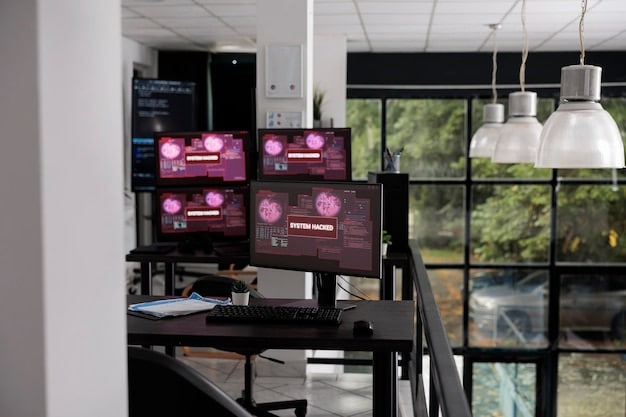Interactive TV: Can Network TV’s “Choose Your Own Adventure” Succeed?

Network TV’s experiment with interactive storytelling, mirroring the “Choose Your Own Adventure” book format, aims to boost viewer engagement by allowing real-time choices that shape the narrative. The success of this venture hinges on viewers embracing this new level of control.
Can television recapture the magic of appointment viewing in the age of streaming? Network TV’s experiment with interactive storytelling: Will Viewers Embrace the Choose-Your-Own-Adventure Format? Is the future of TV watching.
The Evolution of Storytelling: From Passive to Interactive
Television has long been a passive medium, with viewers simply absorbing the stories presented to them. But now, networks are exploring ways to transform that experience into something more active and engaging.
The allure of interactive storytelling lies in its dynamic nature, offering viewers agency over the narrative. This move to interactive formats aims to draw in viewers accustomed to choosing their own paths in video games and streaming services.
The Rise of Interactive Media
Interactive media has been gaining traction for years, particularly in gaming. Now this trend is reaching traditional television.
Benefits of Interactive Television
There are several benefits to interactive television, including increased viewer engagement and potential for new revenue streams.
- Increased Engagement: Viewers become more invested in the story when their decisions matter.
- Novelty: The interactive nature offers a unique viewing experience that can attract new audiences.
- Data Collection: Networks can gather valuable data on viewer preferences, which can be used to improve content.

Interactive storytelling holds the potential to reshape how we consume television. By handing over some control to the audience, networks hope to create a deeply engaging and personalized viewing experience.
The “Choose Your Own Adventure” Model: A Blast from the Past
The “Choose Your Own Adventure” format isn’t new. Before interactive TV, there was interactive storytelling through books that gave people the same experience. Are the two related?
The format’s resurgence in network television signals a nostalgic yet forward-thinking approach to content creation, seeking to reinvent how stories are experienced.
How the Original Books Worked
“Choose Your Own Adventure” books presented readers with choices at the end of each page, leading to different outcomes. This method made the reader part of the story.
Key Elements of the Format
Core elements include branching narratives, multiple endings, and the empowerment of the audience.
- Branching Narratives: Storylines split into multiple paths based on the reader’s decisions.
- Multiple Endings: Each narrative path leads to a unique conclusion, encouraging replayability.
- Reader Empowerment: The reader becomes an active participant, influencing the direction of the story.
This retro format is being revived because of emerging video game and online video popularity. The nostalgic appeal, combined with technological advancements, makes it a perfect fit for contemporary entertainment.
Network Implementation: Practical Challenges and Solutions
Bringing interactive storytelling to network TV comes with unique challenges. How can networks implement this in the most seamless efficient way?
Networks need innovative tech solutions to make sure that the viewer decisions are incorporated live during the broadcast. This requires new infrastructures.

Technological Requirements
Broadcasting interactive television requires substantial technological support.
Technical Challenges of Interactive TV
Several technical hurdles need to be overcome to make interactive TV a reality.
- Real-Time Polling: Networks must implement systems for collecting viewer choices in real time.
- Branching Content: Alternate scenes and storylines must be ready and accessible.
- Seamless Integration: Choices must be integrated smoothly into the broadcast without disrupting viewing.
Networks are working on tech solutions that enhance viewer experience. These solutions include interactive apps, social media integration, and advanced streaming platforms.
Viewer Reception: Will Audiences Embrace Interactivity?
The success of interactive storytelling depends on viewer acceptance. How will audiences react to this new format?
Some viewers may not like having to make decisions while watching. This can remove the passive relaxation that many associate with watching TV.
The Allure of Interactivity
Many viewers may enjoy being actively involved in shaping the story.
Potential Roadblocks to Adoption
There might be some reluctance from audiences regarding it’s newness.
- Decision Fatigue: Constant choices can be tiring for viewers who seek relaxation.
- Preference for Passive Viewing: Some viewers may prefer the traditional, effortless viewing experience.
- Technological Barriers: Not all viewers may have access to the necessary technology or the desire to use it.
Ultimately, the success of interactive television will depend on striking a balance between viewer engagement and simplicity. Networks need to make the interactive experience easy to use, fun, and rewarding. They also need to appeal to a broad audience.
Comparative Analysis: Interactive TV vs. Traditional Formats
How does interactive TV measure up against traditional viewing methods? It is necessary to compare.
Interactive TV offers a unique and immersive experience when compared to traditional TV. It gives viewers control. Traditional TV offers passive relaxation.
Strengths of Interactive TV
Interactive television offers many advantages over traditional formats.
Drawbacks of Interactive TV
There are also some cons of interactive television.
- Production Cost: Creating branching narratives requires more resources.
- Complexity: Interactive shows can be more complex to produce.
- Limited Appeal: Some viewers might find the format irritating or too complicated.
Interactive TV provides viewer participation and customized viewing but needs technological advancement and faces potential production challenges. Traditional TV allows for straightforward content and simple viewing but provides no control. These formats can coexist depending on viewer preferences.
Future Trends: The Evolution of Interactive Television
What does the long term hold for interactive TV? What are the future viewing plans?
Innovations in technology hold the potential to enhance interactive television through virtual reality and augmented reality.
Emerging Technologies and Interactive TV
New technologies can play a significant role in shaping the future of interactive TV.
Long-Term Predictions for Interactive Storytelling
The format is more likely to evolve to create immersive and personalized experiences.
- Personalized Storylines: AI could customize narratives in real time.
- VR and AR Integration: Viewers could step into TV shows.
- Seamless Interactivity: Interactivity may become integrated into everyday viewing habits.
Interactive TV shows a lot of potential because of emerging technologies. Customization, VR and AR, and seamless user experience might become a routine part of TV. This can transform how we watch and engage with TV.
| Key Point | Brief Description |
|---|---|
| 📺 Interactive TV | TV that lets viewers shape the story. |
| 🤔 Viewer Reception | How the public will react to making decisions while watching TV. |
| 🚀 Future Trends | Using tech (VR, AR) to enhance TV. |
| 💡 Benefits | More engaging and adaptable to audience preferences. |
FAQ
▼
Interactive storytelling lets viewers make choices that affect the story’s direction. This gives them an active position unlike regular forms of television shows.
▼
Viewers can participate through apps, websites, or remote control choices. These choices are collected live to determine a tv show outcome.
▼
Networks benefit from higher involvement and insights into viewer preferences. This knowledge helps them customize and improve their material for better results.
▼
Challenges include high costs, technological requirements, and complex production of stories. These problems have to be dealt with in order to be effective.
▼
The future trends will shape interactive TV, and include VR reality, AR, AI customization, and the incorporation of user interfaces that give viewers a better, engaging experience.
Conclusion
Network TV’s experiment with interactive storytelling shows a big change in the way that viewers engage with content. By adopting “Choose Your Own Adventure” tactics, the networks aim to deliver viewers an engaging and personalized experience. Whether the model will work is not yet apparent, because its potential to reinvent how television is watched will depend on technology, audience acceptance, and networks.





